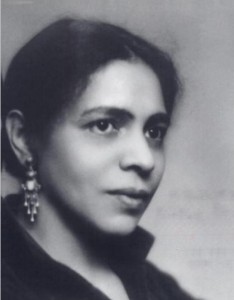

Larsen was born Nellie Walker on April 13, 1891, in Chicago, Illinois, to immigrant parents. Her father, Peter Walker, was a black cook from the West Indies, and her mother, Mary Hanson, was a Danish seamstress. Soon after Larsen was born, her father disappeared. Her mother remarried a white man named Peter Larsen. When Larsen’s younger sister was born, Larsen was the only visibly black person in her nuclear family. This difficult dynamic was exacerbated by her claim that Peter Larsen was ashamed of his African American daughter.
Growing up in a white Chicago suburb, Larsen attended public schools until 1907 when at age 16, she enrolled at Fisk University’s in Nashville, Tennessee. The move to Nashville served to distance Larsen from her family, something she welcomed because of the shame she had been made to feel during her upbringing. Regarding being seen in public with her family, she said her racial ethnicity “might make it awkward for them, particularly my half-sister.”
But Larsen was captivated by mixed race dynamics, which would become central themes in her novels, and after studying at Fisk for only one year, she moved to Denmark for the next four years, attempting to learn about that half of her ancestry. On her return to the United States, she studied to be a nurse in New York. After graduating from that program in 1915, Larsen briefly took a position with the Tuskegee Institute in Alabama, working as a head nurse.
In 1916, Larsen returned to New York where she worked as a nurse at Lincoln Hospital. After the chaos of the Spanish flu pandemic that struck the city in 1918 and 1919, she decided to become a librarian and was employed at the 135th Street branch of the New York Public Library. Also in 1919, Larsen married the well-known physicist, Elmer Imes (he was the second African American to earn a Ph.D. in physics). A prominent member of Harlem’s elite class, Imes provided an entrée for Larsen to become acquainted with the intellectuals of the Harlem Renaissance including W.E.B. Du Bois, Langston Hughes, and Walter White.
Though she and Imes were regular socialites, both in Harlem and in white intellectual circles in Greenwich Village, Larsen immersed herself in literature during her private time. She had a voracious appetite for books, as well as a newly focused passion for creating her own literature. Larsen wrote short stories and poems, and with the help of friends like Du Bois and White, began to publish her work. In 1926, she published several articles in the magazine for African American children, The Brownies’ Book. Under the nom de plume Allen Semi (Nella Imes in reverse), she continued to publish her articles and stories with some success. After publishing a short story titled “Correspondence” in the National Urban League’s literary publication, Opportunity, Larsen devoted herself full time to her budding literary career.
In 1928, Larsen published her first novel, Quicksand, about the struggles and strife involved in being of mixed races in America. She also tackled themes of gender and sexuality, using an ironic and sophisticated approach that was both fresh and unique. Larsen was awarded the Harmon Foundation Bronze Medal for Literature and celebrated as one of the bright stars of the Harlem Renaissance. Just one year later in 1929, she published her second novel, Passing, which solidified her status as a significant literary voice. Passing was met by the critics with great acclaim, and her portrayals of the complexities of racial, sexual, and women’s issues are still considered pertinent and insightful today. On the strength of the book, Larsen became the first black woman to receive a Guggenheim Fellowship for literature. She traveled to Paris and Spain over the next six months, and worked on a third novel.
After publishing a story titled “Sanctuary” in 1930, plagiarism accusations were leveled at Larsen, with some suggesting too close a resemblance to a story published eight years earlier by Sheila Kaye-Smith. The original publishers of the Kaye-Smith story disagreed, and publicly stated their faith in Larsen’s work as being wholly original. But the shock of the accusation had a profound and paralyzing effect on her creative output. Coupled with a public and scandalous divorce involving Imes’ affair with a white woman, Larsen shrank from the limelight. She subsisted on alimony payments from Imes until he died in 1941, at which time she quietly resumed her nursing career. On March 30, 1964, Easter Sunday, Larsen died alone in her apartment in New York. Her body was discovered some time after that, and by then, most of her belongings were missing. Little more than two unfinished novel manuscripts had been left behind.
Larsen never published another word after the scandal involving “Sanctuary,” but her value to American literature is continually growing. Today, many critics consider her to be the greatest novelist of the Harlem Renaissance, and her work continues to be read nationally and internationally.
